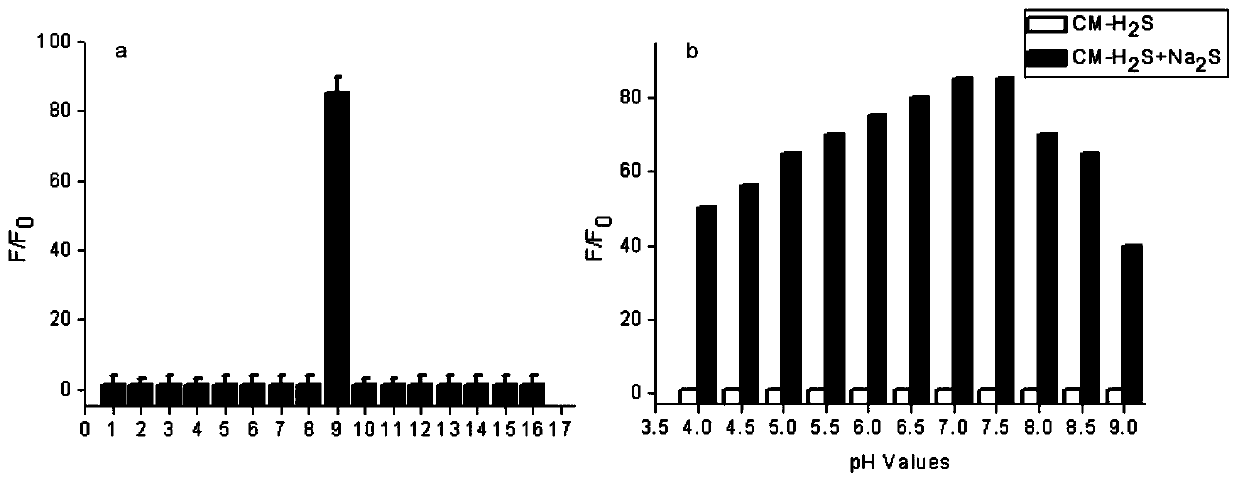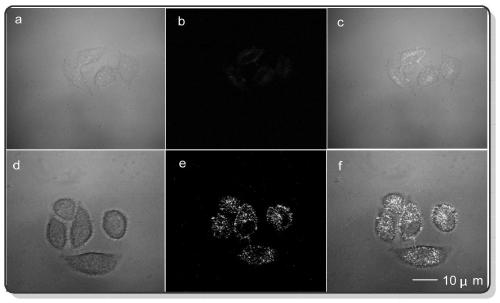Water-soluble double-photon hydrogen sulfide fluorescent probe capable of being used for detecting hydrogen sulfide in red wine and living bodies, and preparation method and application of fluorescent probe
A fluorescent probe, hydrogen sulfide technology, applied in the field of chemical analysis and detection, to achieve the effect of high sensitivity, broad application prospects and high selectivity
- Summary
- Abstract
- Description
- Claims
- Application Information
AI Technical Summary
Problems solved by technology
Method used
Image
Examples
Embodiment 1
[0037] This embodiment provides a method for preparing a water-soluble two-photon hydrogen sulfide fluorescent probe for red wine and in vivo hydrogen sulfide detection, comprising the following steps:
[0038] S1. Synthesis of crude product: 0.193g (1.00mmol) 4-(diethylamino)-salicylaldehyde, 0.186g 2,4-dinitrofluorobenzene (1.00mmol), 0.294g (3mmol) K 2 CO 3 and 40mL CH 3 CN was added to a 100-ml round-bottomed flask, equipped with a circulating condensing device, the mixture was stirred at 65 ° C, and the reaction was followed by thin-layer chromatography until 4-(diethylamino)-salicylaldehyde was completely reacted; the final mixture Pour into an appropriate amount of ice water, and suction filter to obtain a yellow solid. The solid is washed 3 times with cold water, and the solid is dried in a constant temperature drying oven to obtain a solid crude product that is directly used in the next reaction. The structure of the crude product is as shown in formula (II). Shown;...
Embodiment 2
[0044] The present embodiment is a probe molecular detection test, and the results are as follows: image 3 shown.
[0045] Where: (a) is the normalized UV-Vis absorption spectrum of CM-H2S and CM-H2S+Na2S.
[0046] (b) is the fluorescence spectrogram of the response of the probe molecule (1 μM) to hydrogen sulfide, hydrogen sulfide (0-35 μM), the titration experiment of the hydrogen sulfide fluorescent probe and hydrogen sulfide. Use a fluorescence spectrometer to test the fluorescence spectrum under different concentrations of hydrogen sulfide. The excitation wavelength of the fluorescence spectrum is 380nm, the emission wavelength is 500nm, and the detection wavelength is 400-650nm. With the increase of the concentration of sodium sulfide, the fluorescence intensity at 500nm wavelength Gradually enhanced, indicating that the fluorescent probe prepared by the present invention can respond to hydrogen sulfide.
[0047] (c) is the calibration curve.
[0048] (d) is a linear...
Embodiment 3
[0051] This embodiment is a selectivity test for fluorescent probes to detect hydrogen sulfide, and the results are as attached Figure 4 shown.
[0052] Under the same test conditions, the fluorescence spectrum after adding 35 micromoles of hydrogen sulfide or 100 micromoles of other analytes to 1 micromoles of probe molecules. Among them: the excitation wavelength of the fluorescence spectrum is 380nm, the emission wavelength is 500nm, and the detection wavelength is 400-650nm. The results are attached Figure 4 (a) shown.
[0053] attached by Figure 4 (a) It can be seen that numbers 1 to 16 represent blanks (probe molecules) respectively, and S 2 o 3 2- , S 2 o 4 2- , S 2 o 5 2- , SO 3- , GSH, Cys, Hcy, Na 2 S, Ca 2+ , Mg 2+ , Na + , K + , Cu 2+ , Zn 2+ , and Fe 3+ . Only hydrogen sulfide is significantly enhanced in fluorescence intensity, and other bioactive small molecules and other analytes do not interfere with the detection results, indicating th...
PUM
 Login to View More
Login to View More Abstract
Description
Claims
Application Information
 Login to View More
Login to View More - R&D
- Intellectual Property
- Life Sciences
- Materials
- Tech Scout
- Unparalleled Data Quality
- Higher Quality Content
- 60% Fewer Hallucinations
Browse by: Latest US Patents, China's latest patents, Technical Efficacy Thesaurus, Application Domain, Technology Topic, Popular Technical Reports.
© 2025 PatSnap. All rights reserved.Legal|Privacy policy|Modern Slavery Act Transparency Statement|Sitemap|About US| Contact US: help@patsnap.com



